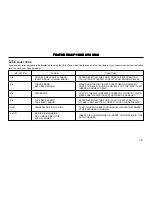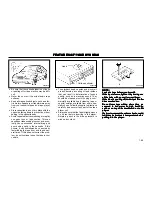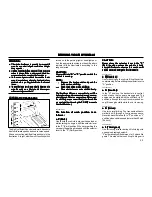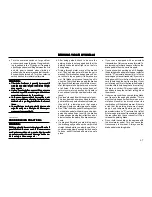
DRIVING YOUR HYUNDAI
DRIVING YOUR HYUNDAI
DRIVING YOUR HYUNDAI
DRIVING YOUR HYUNDAI
DRIVING YOUR HYUNDAI
2- 9
C300D01L-GAT
Indicator and Warning
Indicator and Warning
Indicator and Warning
Indicator and Warning
Indicator and Warning
The indicator should illuminate when the ignition
key is turned to "ON" or "START", but should go
out after three seconds.
If the indicator does not illuminate, have it checked
by an authorized Hyundai dealer.
Should there be any unusual conditions in the
device, TCS illuminates as a warning.
If TCS illuminates, pull your car to a safe place
and stop the engine.
Then, start the engine again to check if the TCS
indicator goes out.
If the indicator remains lit even after the engine
has been started, have your car checked by an
authorized Hyundai dealer.
NOTE:
NOTE:
NOTE:
NOTE:
NOTE:
1)
1)
1)
1)
1) Turn off the engine. Then restart the en-
Turn off the engine. Then restart the en-
Turn off the engine. Then restart the en-
Turn off the engine. Then restart the en-
Turn off the engine. Then restart the en-
gine, and the TCS mode will automatically
gine, and the TCS mode will automatically
gine, and the TCS mode will automatically
gine, and the TCS mode will automatically
gine, and the TCS mode will automatically
turn "ON".
turn "ON".
turn "ON".
turn "ON".
turn "ON".
2)
2)
2)
2)
2) When the traction control is operating
When the traction control is operating
When the traction control is operating
When the traction control is operating
When the traction control is operating
properly, you can feel a slight pulsation in
properly, you can feel a slight pulsation in
properly, you can feel a slight pulsation in
properly, you can feel a slight pulsation in
properly, you can feel a slight pulsation in
the vehicle. This is only the effect of brake
the vehicle. This is only the effect of brake
the vehicle. This is only the effect of brake
the vehicle. This is only the effect of brake
the vehicle. This is only the effect of brake
control and indicates nothing unusual.
control and indicates nothing unusual.
control and indicates nothing unusual.
control and indicates nothing unusual.
control and indicates nothing unusual.
3)
3)
3)
3)
3) When the engine starts, a click is heard
When the engine starts, a click is heard
When the engine starts, a click is heard
When the engine starts, a click is heard
When the engine starts, a click is heard
from the engine compartment; however,
from the engine compartment; however,
from the engine compartment; however,
from the engine compartment; however,
from the engine compartment; however,
this is only the sound of traction control
this is only the sound of traction control
this is only the sound of traction control
this is only the sound of traction control
this is only the sound of traction control
being checked.
being checked.
being checked.
being checked.
being checked.
4)
4)
4)
4)
4) When moving out of the mud or fresh
When moving out of the mud or fresh
When moving out of the mud or fresh
When moving out of the mud or fresh
When moving out of the mud or fresh
snow, pressing the accelerator pedal may
snow, pressing the accelerator pedal may
snow, pressing the accelerator pedal may
snow, pressing the accelerator pedal may
snow, pressing the accelerator pedal may
not cause the engine speed to increase.
not cause the engine speed to increase.
not cause the engine speed to increase.
not cause the engine speed to increase.
not cause the engine speed to increase.
NOTE:
NOTE:
NOTE:
NOTE:
NOTE:
1)
1)
1)
1)
1) When TCS illuminates, traction control is
When TCS illuminates, traction control is
When TCS illuminates, traction control is
When TCS illuminates, traction control is
When TCS illuminates, traction control is
automatically deactivated for safety.
automatically deactivated for safety.
automatically deactivated for safety.
automatically deactivated for safety.
automatically deactivated for safety.
2)
2)
2)
2)
2) This warning function is not provided when
This warning function is not provided when
This warning function is not provided when
This warning function is not provided when
This warning function is not provided when
in the TCS-OFF mode.
in the TCS-OFF mode.
in the TCS-OFF mode.
in the TCS-OFF mode.
in the TCS-OFF mode.
C140A01A-AAT
DRIVING FOR ECONOMY
DRIVING FOR ECONOMY
DRIVING FOR ECONOMY
DRIVING FOR ECONOMY
DRIVING FOR ECONOMY
You can save fuel and get more miles from your
car if you follow these suggestions:
o Drive smoothly. Accelerate at a moderate
rate. Don't make "jack-rabbit" starts or full-
throttle shifts and maintain a steady cruising
speed. Don't race between stoplights. Try to
adjust your speed to that of the other traffic so
you don't have to change speeds unneces-
sarily. Avoid heavy traffic whenever possible.
Always maintain a safe distance from other
vehicles so you can avoid unnecessary brak-
ing. This also reduces brake wear.
o Drive at a moderate speed. The faster you
drive, the more fuel your car uses. Driving at
a moderate speed, especially on the high-
way, is one of the most effective ways to
reduce fuel consumption.
o Don't "ride" the brake or clutch pedal. This
can increase fuel consumption and also in-
crease wear on these components. In addi-
tion, driving with your foot resting on the brake
pedal may cause the brakes to overheat,
which reduces their effectiveness and may
lead to more serious consequences.
o Take care of your tires. Keep them inflated to
the recommended pressure. Incorrect infla-
tion, either too much or too little, results in
unnecessary tire wear. Check the tire pres-
sures at least once a month.
o Be sure that the wheels are aligned correctly.
Improper alignment can result from hitting
curbs or driving too fast over irregular surfac-
es. Poor alignment causes faster tire wear
and may also result in other problems as well
as greater fuel consumption.
o Keep your car in good condition. For better
fuel economy and reduced maintenance
costs, maintain your car in accordance with
the maintenance schedule in Section 5. If you
drive your car in severe conditions, more
frequent maintenance is required (see Sec-
tion 5 for details).
o Keep your car clean. For maximum service,
your Hyundai should be kept clean and free of
corrosive materials. It is especially important
that mud, dirt, ice, etc. not be allowed to
accumulate on the underside of the car. This
extra weight can result in increased fuel con-
sumption and also contribute to corrosion.
o Travel lightly. Don't carry unnecessary weight
in your car. Weight reduces fuel economy.
o Don't let the engine idle longer than neces-
sary. If you are waiting (and not in traffic), turn
off your engine and restart only when you're
ready to go.
Содержание 2001 Elantra
Страница 1: ...D R I V I N G IS B E L I E V I N G 2001 ...
















































